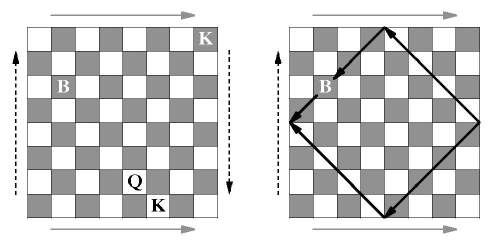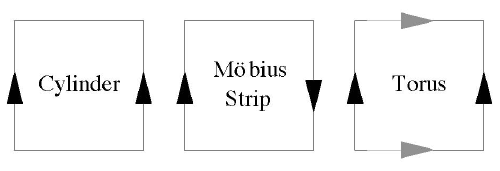Problem of the Week 1058Nonorientable ChessThe diagram at left below represents a chess position on a board that is a Klein bottle (explanation below). It is White's turn to play. Find a move for White that checkmates Black. How many such moves are there?
Notes. If the left and right sides of a rectangle are identified, the rectangle becomes a cylinder. You can see this by taking this piece of paper and curving it so that the left and right touch each other. If you remember Pac-Man video games you know that if both the left and right sides are identified, and also the top and bottom edges, one gets a torus. Think of this as a cylinder twisted so that the top aligns with the bottom. If one identifies left and right edges, but turns the right edge upside down before bringing it around to the left side, then one has a Möbius strip. Such a surface is nonorientable: it has only one side.
To get a Klein bottle, which is a closed surface with no inside or outside, wrap the top edge to the bottom in the ordinary way but wrap the right edge to the left with a twist. To get the idea, recall that in ordinary chess bishops are restricted to squares of one color. Not so on a Klein bottle. The White bishop on the black square (b6; see figure on right, above) can move down and left to the black square (a5) but if he continues, he goes to the white square at h5, because of the direction reversal when crossing over. If he continues moving, he would go upward to g6, f7, e8 and then, carrying on to the bottom, d1, c2, b3, a4, h4, g3, f2, e1, d8, c7, and finally back home to b6. Source: Timothy Chow, The Mathematical Intelligencer, 28:2, Spring 2006, page 49. © Copyright 2006 Stan Wagon. Reproduced with permission. |

